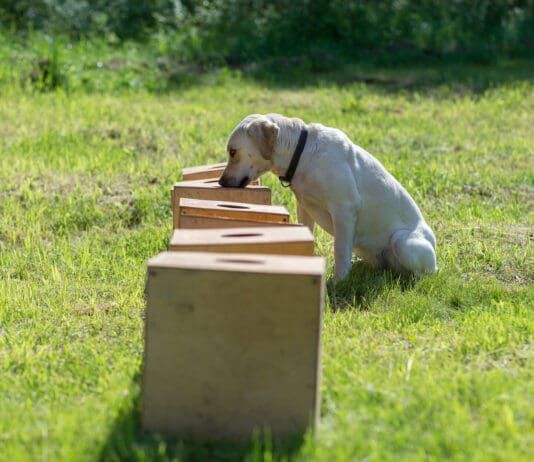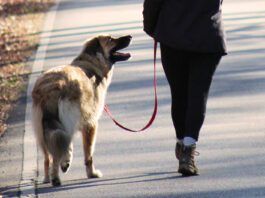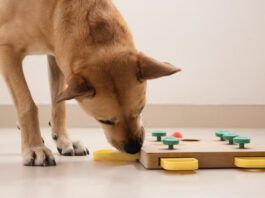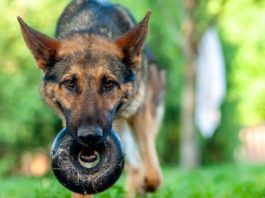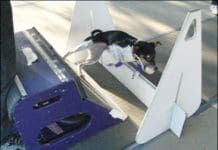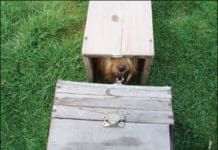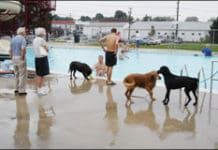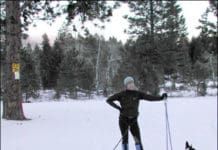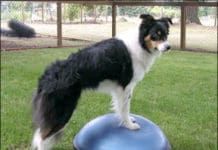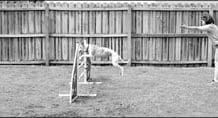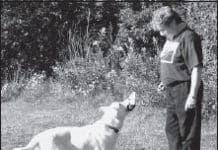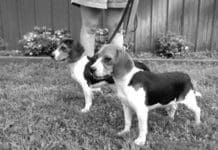High-Energy Canine Competitions
Woof, yap, scream, yodel, bark, yip. Go, go, go!” Dogs on the sidelines and in crates and exercise pens barking at the top of their lungs. Dogs tugging and growling, tugging and growling. Handlers yelling over the din to their teammates. Handlers recalling their dogs over jumps, H-e-r-e! Event officials blowing whistles and announcing the next race over bullhorns or speaker systems, and start-line lights and passing lights flashing on and off. Flyball is a cacophony of sights and sounds. It is exhilarating, over the top, adrenalized hyperstimulation. This is not a sport for the introverted, timid, or sound-sensitive dog or handler. The adrenalin level is off the charts and you can hear that from hundreds of yards away. The first time I experienced flyball was as a spectator at an obedience trial held at a park. Suddenly, shattering the decorum, was an ear-piercing scream followed by rabid barking. Certain that an obedience dog had left the ring and treed a critter, I raced over to watch. No critter. No mayhem. Just flyball. The teams had just set up for their first race and the dogs were ready. I had never seen dogs so keen to get going.
Earthdog, An Underground Dog Training Activity
As long as there have been farmers and hunters, there have been “earth dogs.” Hardy, scrappy little dogs helped hunters tree squirrels, run rabbits to ground, corner foxes in their dens, and clear vermin from dwellings. As often happens, humans found a way to create competitive games from dogs’ natural abilities. For terriers and Dachshunds, a sport is born. Earthdog! Get that rat! As early as 211 B.C., mention was made of tiny rough-coated dogs used to follow animals into their burrows. Later, in the 1576 book De Canibus Anglicis, by Johannes Caius, the use of terriers was described in detail. In 1935, after many years of friends gathering together to test their dogs’ capabilities against those of their friends’ dogs, the Dachshund Club started offering trials modeled after German training for fox and badger hunting. This included building underground tunnels up to 50 feet long, with twists and turns along the way that required dogs to make decisions about which way to go to find their quarry. And it’s dark down there! In 1941 the Sealyham Terrier Club issued the first “working certificate,” which outlined requirements for dogs to search out woodchucks. In 1971 the American Working Terrier Association (AWTA) started artificial den trials in the U.S. By 1994, the American Kennel Club had launched its Earthdog program.
Canine Swimming Lessons: The Perfect Exercise For Your Dog
For those of us who regularly swim for fitness, we know why swimming is often referred to as “the perfect exercise.” In addition to the physical benefits shared with other forms of aerobic exercise, swimming offers some unique benefits. It eliminates the effects of weight-bearing on the joints, exercises the entire body – upper and lower – at the same time, and, in most cases, is something we can do for our entire lives, even if age precludes us from taking part in other forms of exercise. The physical benefits of swimming are the same for your canine companion as they are for you – that is, if you have a dog who will swim. Even though they actually have a stroke named after them, the notion that all dogs are “natural swimmers” is an erroneous one. Some breeds were developed to work in water and are more physically adapted for swimming than others. The problem here is not getting these dogs into the water, but keeping them on terra firma when we want them to stay clean and dry. However, occasionally, even a water breed shows disdain for water – yes, there are some Labrador Retrievers who hate swimming. Conversely, there are dogs you’d never imagine taking kindly to the water who become devoted and skilled swimmers. Although not blessed with the physical advantages of a water breed, and despite sinking rear ends or heavy, wet coats, these Boston Terriers, Rhodesian Ridgebacks, and Siberian Huskies have learned to enjoy swimming. They don’t know or care that they have to work a little harder than a Poodle, Cocker Spaniel, or a Newfoundland – they just want to have fun!
Tug O’ War is a Fun Game to Play With Your Dog
Contrary to conventional wisdom in some dog training circles, tug is a great game to play with most dogs - as long as you and your canine pal play by the rules. Lots of my clients have dogs with aggressive, reactive, and other stress-related behaviors. One of the best ways to help reduce stress is to increase exercise. Tug is great exercise. I'm constantly encouraging my clients to play tug with their dogs. Inevitably when I suggest it I get a puzzled look and a tentative protest that "some trainer" told them playing tug would make their dog dominant and aggressive. I sure wish I could meet that pervasive "some trainer" some day and convince him/her otherwise. It just isn't so. Tug has a lot going for it besides just being good exercise. Most dogs love to tug. Of course, the caveat is that you play tug properly - with rules, which I'll discuss in a minute. Here are some of the many other reasons this game ranks high on my list of approved activities.
Fun Dog Activities
which raises funds for area shelters.
Winter Activities You Can Enjoy With Your Dog
courtesy of skijornow.com.üThe author and her dogs
Canine Sports and Proper Canine Injury Prevention Through Conditioning
Today's explosion of canine sports has made sports medicine a veterinary specialty. But, says Carol Helfer, DVM, at Canine Peak Performance Sports Medicine & Physical Rehabilitation Center in Portland, Oregon, competing dogs are prone to injury not because their sports are inherently dangerous but because canine athletes seldom receive the conditioning training that keeps them strong, balanced, and coordinated. The whole notion of injury prevention through proper conditioning is one that is just beginning to gather attention,h explains Dr. Helfer. What I love about this work is that a few simple exercises can dramatically change a dog's quality of life. In athletic dogs, the proof is in their continued good health, enhanced performance, and absence of injuries. Elderly and sedentary dogs benefit, too, and they quickly show increased range of motion and a renewed enthusiasm for activities."
Athletic Dogs and Acupressure Techniques
When spring is in the air, every dog knows it. Spring is the season when dogs want to run, play, and stretch their bodies, when their eyes brighten, and their natural zest for life flows through their veins. Spring is a time of action. There are so many canine performance sports today that require peak levels of running, twisting, turning, jumping, and pivoting. Anyone watching a canine agility trial or flyball competition can see the adrenaline pumping through every ounce of the dog's being. Adrenaline can override the senses and the animal can unknowingly hurt himself badly, especially early in the season. The risk of injury is very high when a dog is not properly conditioned. Also, dogs need to be given the opportunity to warm up before engaging in the burst of excitement and energy they experience at the moment they are released for coursing, a herding test, or on a sledding trail.
Agility Games for Managing Dog Aggression
Owning an aggressive, fearful, or other type of special needs" dog is stressful. When your dog overreacts to other dogs or just the stimulus of being out in the world by barking
Teaching a Dog to Play Fetch
Last week a trainer friend stopped by to visit with her three dogs: Star, Kaiya, and Lhotse. As we were chatting, Laura confessed to me that she thought she'd ruined Star's "fetch" with the clicker. "She had a great retrieve," Laura said, "until I started clicking her for it. Now she just drops it as soon as I click. I stopped working on it because I knew I was messing it up." I chuckled to myself. I knew this would be a fun - and easy - training fix.
Your Dog’s Ability to Track Scents
Humans have taken advantage of dogs' incredibly keen sense of smell over the ages for such uses as hunting, tracking lost and fugitive humans, and more recently, the detection of bombs, narcotics, and other contraband. It's well known that a dog's nose is many times sharper than our own estimates range from 10,000 to 100,000 times superior to ours, with a far greater number and variety of scent receptors in their noses, more neurons linking the nose to the brain, and a greater proportion of their brains devoted to smell.


